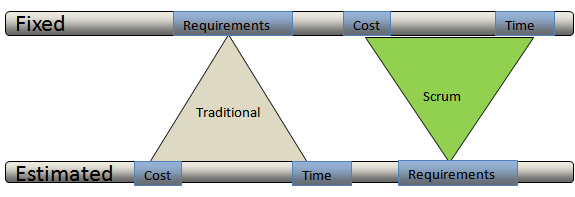Scrum has been around for nearly 20 years but has recently gained ground as a front-runner in the agile methodology practice group. Due to its approach to project requirements and fast iterative development cycles, Scrum will gain even more popularity as businesses are adopting lean processes, streamlining controls and cutting out waste. It brings a faster, more complete development modules and project owner involvement to ensure that current and future business goals are met.
Scrum is a value-driven management agile methodology that focuses on delivering small incremental batches of requirements within some given time frame and budget. One goal is to realize business value (ROI) on deliverables as soon as possible so businesses can make more informed decisions for future Scrums.
Scrum vs. Traditional Development Methods
Scrum methodology concentrates on incremental release cycles of useable deliverables. Requirements are placed on a product backlog list, which are then detailed into the Scrum backlog and pulled into a release for work. Project owners have full control over the backlog list and the priority of the work that is schedule to be done in each release. The release dates and budget for each Scrum iteration or sprint remain fixed, while the requirement (scope) remains flexible.
“Flexible scope” is a scary phrase for any project manager. In reality, when a project begins with high-level requirements and scope, the result is often different from the start. Throughout the project, the requirements are revised, changed and sometimes even removed.
With the Scrum methodology, both the cost and time for each iteration are fixed, ensuring budget and schedule control, while the project owner controls requirements (scope).
The process starts out with a backlog of requirements that the project owner prioritizes. Then, the project team decides how many requirements can be placed in a Scrum sprint. Requirements are further detailed and placed on the Scrum backlog. This is a just-in-time process for feeding into the Scrum sprint. It’s recommended that sprints run 1-3 weeks, depending on the needs of the project. The point is to keep them small, delivering working product frequently.
This allows for ROI to be recognized sooner than with traditional methods. Waterfall methods do not make ROI apparent until closer to the project end, which in some cases can be years. This makes Scrum a fiscally advantageous methodology for long-term projects.
Waterfall methods often result in systems that no longer provide the expected value because they’re out of date by the time of delivery or are in a never-ending mode of change. Scrum value-driven management helps to avoid these issues by quickly delivering high-priority requirements (as denoted by the product owner), which allows the product owner to revaluate the benefits of each requirement and adjust as needed.
Would faster delivery and ROI be factors in making a decision on a project methodology?


Kim,
This is an excellent blog. It was an easy read with a lot of pertinent information for businesses in today’s economy. Thanks for sharing.
Tara
Thanks for sharing Kim,
Scrum is definitely gaining ground since Agile is also gaining ground. Agile and Scrum will have quite a boom once Agile is adopted on a larger scale (and, from the look of it, it seems that this era is coming). Agile has a few issues to be sorted out, especially the issue of scaling and the other limitations. However, more and more people and companies are adopting Agile, and maybe one day it will prove itself in a large, non IT project. Great times are coming for Agile and Scrum.
Thank you for commenting. I agree, while Agile is gaining ground there is still more work to be done. We have had success in blending elements of Scrum with traditional methods, to bridge the limitation gaps. It’s definitely a tool that should be added to the PM tool box.